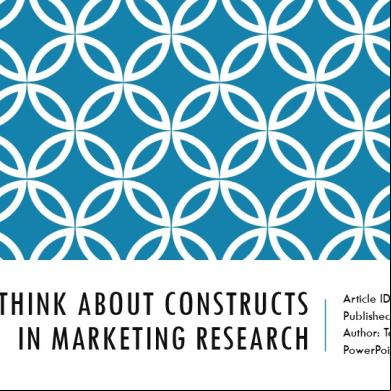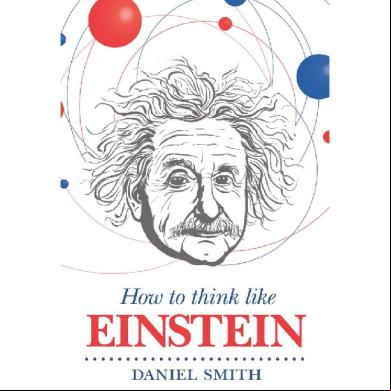How To Think About Constructs In Marketing Research.pdf gb29
This document was ed by and they confirmed that they have the permission to share it. If you are author or own the copyright of this book, please report to us by using this report form. Report 2z6p3t
Overview 5o1f4z
& View How To Think About Constructs In Marketing Research.pdf as PDF for free.
More details 6z3438
- Words: 1,038
- Pages: 10
HOW TO THINK ABOUT CONSTRUCTS IN MARKETING RESEARCH
Article ID: 20150808 Published: August 2015, Pg. 40 Author: Terry Grapentine PowerPoint: Raja Rub Nawaz
WHAT IS A CONCEPT/CONSTRUCT? Real-world example Consider the concept of “chair.” I use the term “concept” instead of “construct” because this example is not based on using the concept of chair in a scientific investigation; however, the example will help you understand how concepts and constructs are similar
Definition (from Fig1 in mind) A generalized abstraction of some aspect of reality that we want to understand for the purposes of communicating to others RAJA RUB NAWAZ
2
WITHIN THE REALM OF THOUGHT We will use the idea of perceived smartphone product quality to explain how mental states, nominal and operational definitions of constructs relate to each other Circle A: Researchers assume that “something like” a product quality construct exists as a hypothetical mental state in consumers’ minds. I say “something like” because this construct refers to an aspect of consciousness that does not have objective reality like, say, a cup of coffee does Circle B: A nominal definition is the meaning of a term using other , like a dictionary definition Circle C: The operational definition of a construct describes how a construct is to be measured
RAJA RUB NAWAZ
3
WHAT ABOUT SMALL ALPHABETS? Letter d : Circles A and B do not perfectly overlap because researchers do not possess perfect knowledge of Circle A. For example, letter d denotes information in Circle A that is not captured by the nominal definition in Circle B Letter e : In some situations, the researcher’s nominal definition may contain information about Circle A that is incorrect, denoted by the letter e. For example, a researcher may have included information about a smartphone’s ergonomic design in the nominal definition of product quality (e.g., “easy to see display in sunlight”); whereas, ergonomics is more properly construed as a construct separate from product quality Letter f : Measurement error is introduced into these operational definitions if they measure properties not part of Circle A – denoted by f – or if they exclude properties in Circle A, denoted by d. Area f, for instance, might be an attribute measuring the perceived weight of a smartphone, which is not part of Circles A or B. For example, “weight” may be part of an “ease of handling” construct RAJA RUB NAWAZ
4
HOW DO WE KNOW HOW MUCH OVERLAP IS THERE IN THREE CIRCLES? How does one ever know how much overlap there is among Circles A, B and C, and whether something like Circle A even exists in consumers’ minds? I discuss this topic in the following three step process of creating and examining marketing constructs: 1. nominal definition meaningfulness; 2. operational definitions; and 3. operational definition validity
All three steps help the researcher address the idea of construct validity. Construct Validity : In its simplest conceptualization, construct validity is the extent to which a construct measure (Circle C) accurately measures the construct it is intended to measure (Circle A) RAJA RUB NAWAZ
5
STEP 1: EXAMINING NOMINAL DEFINITION MEANINGFULNESS The first step in examining the potential usefulness of a construct is to assess how meaningful the construct is. A construct is meaningful to the extent that it helps a researcher explain, understand, predict and ultimately influence some aspect of consumer behavior such as, “Why do consumers purchase our competitors’ products and not ours?” This examination is made after conducting the exploratory research but before launching the quantitative study. Suggested steps to follow are discussed below. Identify the constructs Show how these constructs relate to each other within a theoretical framework Critique each construct in the model
RAJA RUB NAWAZ
6
HOW TO CRITIQUE A CONSTRUCT? Questions to ask for each construct are as follows: What basic idea does this construct capture and is it meaningful? Examine a construct’s nominal definition. Does the language being used to define the construct capture its intended meaning? Do the construct’s listed properties reflect that construct and not some other construct? Have any constructs been omitted? Perhaps a construct needs to be added? Are the constructs distinctive? Whether a) some of the constructs should be combined into one; or b) a given construct should be divided into one or more constructs. Are the relationships among the constructs specified correctly?
RAJA RUB NAWAZ
7
STEP 2: EXAMINING THE OPERATIONAL DEFINITION A construct’s operational definition is a description of how a construct is to be measured and it focuses on all aspects of construct measurement Each of the construct’s properties should be measured with at least one attribute (a) and (c) are same (d) could be split in to two – submerged and splashed
Test the attributes with target respondents
RAJA RUB NAWAZ
8
STEP 3: OPERATIONAL DEFINITION VALIDITY AND RELIABILITY This phase of construct development and refinement assumes that the constructs being used in the study have ed a rigorous examination of their nominal definition meaningfulness and operational definitions Construct Validity Convergent validity Discriminant validity
Reliability RAJA RUB NAWAZ
9
REFERENCES 1.
Goertz, Gary (2006), Social Science Concepts: A s Guide. Princeton University Press, Princeton, N.J.
2.
Kerlinger, Fred N., and Howard B. Lee (2000), Foundations of Behavioral Research. Harcourt College Publishers, New York, page 4.
3.
Jaccard, James and Jacob Jacoby (2010), Theory Construction and Model Building. The Guilford Press, New York, page 11.
4.
Zaltman, Gerald and Christian R.A. Pinson, and Reinhard Angelmar (1973), Metatheory and Consumer Research. Holt, Rinehart and Winston, New York, p. 22.
5.
Teas, Kenneth R., and Kay M. Palan (1977), “The realms of scientific meaning framework for constructing theoretically meaningful nominal definitions of marketing concepts.” Journal of Marketing, April, pages 5267.
6.
Churchill Jr., Gilbert A., (2001), Basic Marketing Research. The Dryden Press, New York, p. 370371.
7.
Zeller, Richard A., and Edward G. Carmines (1980), Measurement in The Social Sciences. Cambridge University Press, London, p. 81.
8.
Malhotra, Naresh K., (2010), Marketing Research: An Applied Orientation, 6th Ed. Prentice Hall, New York, p. 289.
9.
Malhotra, (2010), p. 289.
RAJA RUB NAWAZ
10
Article ID: 20150808 Published: August 2015, Pg. 40 Author: Terry Grapentine PowerPoint: Raja Rub Nawaz
WHAT IS A CONCEPT/CONSTRUCT? Real-world example Consider the concept of “chair.” I use the term “concept” instead of “construct” because this example is not based on using the concept of chair in a scientific investigation; however, the example will help you understand how concepts and constructs are similar
Definition (from Fig1 in mind) A generalized abstraction of some aspect of reality that we want to understand for the purposes of communicating to others RAJA RUB NAWAZ
2
WITHIN THE REALM OF THOUGHT We will use the idea of perceived smartphone product quality to explain how mental states, nominal and operational definitions of constructs relate to each other Circle A: Researchers assume that “something like” a product quality construct exists as a hypothetical mental state in consumers’ minds. I say “something like” because this construct refers to an aspect of consciousness that does not have objective reality like, say, a cup of coffee does Circle B: A nominal definition is the meaning of a term using other , like a dictionary definition Circle C: The operational definition of a construct describes how a construct is to be measured
RAJA RUB NAWAZ
3
WHAT ABOUT SMALL ALPHABETS? Letter d : Circles A and B do not perfectly overlap because researchers do not possess perfect knowledge of Circle A. For example, letter d denotes information in Circle A that is not captured by the nominal definition in Circle B Letter e : In some situations, the researcher’s nominal definition may contain information about Circle A that is incorrect, denoted by the letter e. For example, a researcher may have included information about a smartphone’s ergonomic design in the nominal definition of product quality (e.g., “easy to see display in sunlight”); whereas, ergonomics is more properly construed as a construct separate from product quality Letter f : Measurement error is introduced into these operational definitions if they measure properties not part of Circle A – denoted by f – or if they exclude properties in Circle A, denoted by d. Area f, for instance, might be an attribute measuring the perceived weight of a smartphone, which is not part of Circles A or B. For example, “weight” may be part of an “ease of handling” construct RAJA RUB NAWAZ
4
HOW DO WE KNOW HOW MUCH OVERLAP IS THERE IN THREE CIRCLES? How does one ever know how much overlap there is among Circles A, B and C, and whether something like Circle A even exists in consumers’ minds? I discuss this topic in the following three step process of creating and examining marketing constructs: 1. nominal definition meaningfulness; 2. operational definitions; and 3. operational definition validity
All three steps help the researcher address the idea of construct validity. Construct Validity : In its simplest conceptualization, construct validity is the extent to which a construct measure (Circle C) accurately measures the construct it is intended to measure (Circle A) RAJA RUB NAWAZ
5
STEP 1: EXAMINING NOMINAL DEFINITION MEANINGFULNESS The first step in examining the potential usefulness of a construct is to assess how meaningful the construct is. A construct is meaningful to the extent that it helps a researcher explain, understand, predict and ultimately influence some aspect of consumer behavior such as, “Why do consumers purchase our competitors’ products and not ours?” This examination is made after conducting the exploratory research but before launching the quantitative study. Suggested steps to follow are discussed below. Identify the constructs Show how these constructs relate to each other within a theoretical framework Critique each construct in the model
RAJA RUB NAWAZ
6
HOW TO CRITIQUE A CONSTRUCT? Questions to ask for each construct are as follows: What basic idea does this construct capture and is it meaningful? Examine a construct’s nominal definition. Does the language being used to define the construct capture its intended meaning? Do the construct’s listed properties reflect that construct and not some other construct? Have any constructs been omitted? Perhaps a construct needs to be added? Are the constructs distinctive? Whether a) some of the constructs should be combined into one; or b) a given construct should be divided into one or more constructs. Are the relationships among the constructs specified correctly?
RAJA RUB NAWAZ
7
STEP 2: EXAMINING THE OPERATIONAL DEFINITION A construct’s operational definition is a description of how a construct is to be measured and it focuses on all aspects of construct measurement Each of the construct’s properties should be measured with at least one attribute (a) and (c) are same (d) could be split in to two – submerged and splashed
Test the attributes with target respondents
RAJA RUB NAWAZ
8
STEP 3: OPERATIONAL DEFINITION VALIDITY AND RELIABILITY This phase of construct development and refinement assumes that the constructs being used in the study have ed a rigorous examination of their nominal definition meaningfulness and operational definitions Construct Validity Convergent validity Discriminant validity
Reliability RAJA RUB NAWAZ
9
REFERENCES 1.
Goertz, Gary (2006), Social Science Concepts: A s Guide. Princeton University Press, Princeton, N.J.
2.
Kerlinger, Fred N., and Howard B. Lee (2000), Foundations of Behavioral Research. Harcourt College Publishers, New York, page 4.
3.
Jaccard, James and Jacob Jacoby (2010), Theory Construction and Model Building. The Guilford Press, New York, page 11.
4.
Zaltman, Gerald and Christian R.A. Pinson, and Reinhard Angelmar (1973), Metatheory and Consumer Research. Holt, Rinehart and Winston, New York, p. 22.
5.
Teas, Kenneth R., and Kay M. Palan (1977), “The realms of scientific meaning framework for constructing theoretically meaningful nominal definitions of marketing concepts.” Journal of Marketing, April, pages 5267.
6.
Churchill Jr., Gilbert A., (2001), Basic Marketing Research. The Dryden Press, New York, p. 370371.
7.
Zeller, Richard A., and Edward G. Carmines (1980), Measurement in The Social Sciences. Cambridge University Press, London, p. 81.
8.
Malhotra, Naresh K., (2010), Marketing Research: An Applied Orientation, 6th Ed. Prentice Hall, New York, p. 289.
9.
Malhotra, (2010), p. 289.
RAJA RUB NAWAZ
10










